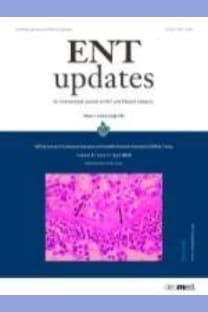Turkish translation, cross-cultural adaptation and validation of the SinoNasal Outcome Test (SNOT)-22
Sinonazal Sonuç Testinin (SNOT-22) Türkçeye çevirisi, kültürler arası adaptasyonu ve validasyonu
___
- 1. Meltzer EO, Hamilos DL, Hadley JA, et al.; American Academy of Allergy, Asthma and Immunology; American Academy of Otolaryngic Allergy; American Academy of Otolaryngology-Head and Neck Surgery; American College of Allergy, Asthma and Immunology; American Rhinologic Society. Rhinosinusitis: estab- lishing definitions for clinical research and patient care. Otolaryngol Head Neck Surg 2004;131(6 Suppl):S162.
- 2. Lange B, Thilsing T, Al-kalemji A, Baelum J , Martinussen T, Kjeldsen A. The Sino-Nasal Outcome Test 22 validated for Danish patients. Dan Med Bull 2011;58:A4235.
- 3. Marambaia PP, Lima MG, Santos KP, Gomes Ade M, de Sousa MM, Marques ME. Evaluation of the quality of life of patients with chronic rhinosinusitis by means of the SNOT-22 question- naire. Braz J Otorhinolaryngol 2013;79:548.
- 4. Lachanas VA, Tsea M, Tsiouvaka S, Hajiioannou JK, Skoulakis CE, Bizakis J G. The sino-nasal outcome test (SNOT)-22: valida- tion for Greek patients. Eur Arch Otorhinolaryngol 2014;271: 27238.
- 5. de Dorlodot C, Horoi M, Lefebvre P, et al. French adaptation and validation of the sino-nasal outcome test-22: a prospective cohort study on quality of life among 422 subjects. Clin Otolaryngol 2015;40:2935.
- 6. Hastan D, Fokkens WJ , Bachert C, et al. Chronic rhinosinusitis in Europe an underestimated disease. A GAÇLEN study. Allergy 2011;66:121623.
- 7. Blackwell DL, Lucas JW, Clarke TC. Summary health statistics for U.S. adults: national health interview survey, 2012. Vital Health Stat 10 2012;(260):1161.
- 8. Vaitkus S, Padervinskis E, Balsevicius T, et al. Translation, cross- cultural adaptation, and validation of the sino-nasal outcome test (SNOT)-22 for Lithuanian patients. Eur Arch Otorhinolaryngol 2013;270:18438.
- 9. Abdalla S, Alreefy H, Hopkins C. Prevalence of sinonasal outcome test (SNOT-22) symptoms in patients undergoing surgery for chronic rhinosinusitis in the England and Wales National prospective audit. Clin Otolaryngol 2012;37:27682.
- 10. Schalek P, Otruba L, Hahn A. Quality of life in patients with chronic rhinosinusitis: a validation of the Czech version of SNOT-22 questionnaire. Eur Arch Otorhinolaryngol 2010;267: 4735.
- 11. Kosugi EM, Chen VG, Fonseca VM, Cursino MM, Mendes Neto JA, Gregório LC. Translation, cross-cultural adaptation and vali- dation of SinoNasal Outcome Test (SNOT): 22 to Brazilian Portuguese. Braz J Otorhinolaryngol 2011;77:6639.
- 12. Caminha GP, Melo Junior JT, Hopkins C, Pizzichini E, Pizzichini MM. SNOT-22: psychometric properties and cross- cultural adaptation into the Portuguese language spoken in Brazil. Braz J Otorhinolaryngol 2012;78:349.
- 13. Piccirillo JF, Merritt MG Jr, Richards ML. Psychometric and clinimetric validity of the 20-Item Sino-Nasal Outcome Test (SNOT-20). Otolaryngol Head Neck Surg 126:417.
- 14. Hopkins C, Gillett S, Slack R, Lund VJ , Browne JP. Psychometric validity of the 22-item Sinonasal Outcome Test. Clin Otolaryngol 2009;34:44754.
- 15. Jalessi M, Farhadi M, Kamrava SK, et al. The reliability and valid- ity of the persian version of sinonasal outcome test 22 (snot 22) questionnaires. Iran Red Crescent Med J 2013;15:4048.
- 16. Kennedy JL, Hubbard MA, Huyett P, Patrie JT, Borish L, Payne SC. Sino-nasal outcome test (SNOT-22): a predictor of postsur- gical improvement in patients with chronic sinusitis. Ann Allergy Asthma Immunol 2013;111:24651.e2.
- 17. Seferlis F, Proimos E, Chimona TS, Asimakopoulou P, Papadakis CE. SNOT-22 validation in Greek patients. ORL J Otorhinolaryngol Relat Spec 2014;76:20711.
- 18. de los Santos G, Reyes P, Del Castillo R, Fragola C, Royuela A. Cross-cultural adaptation and validation of the sino-nasal outcome test (SNOT-22) for Spanish-speaking patients. Eur Arch Otorhinolaryngol 2014 doi:10.1007/s00405-014-3437-0
- 19. Fokkens WJ , Lund VJ , Mullol J , et al. EPOS 2012: European position paper on rhinosinusitis and nasal polyps 2012. A summa- ry for otorhinolaryngologists. Rhinology 2012;50:112.
- 20. Morley AD, Sharp HR. A review of sinonasal outcome scoring systems which is best? Clin Otolaryngol 2006;31:1039.
- 21. Koller M, Aaronson NK, Blazeby J , et al.; EORTC Quality of Life Group. Translation procedures for standardized quality of life questionnaires: the European Organization for Research and Treatment of Cancer (EORTC) approach. Eur J Cancer 2007;43: 181020.
- 22. Gregório LL, Andrade J S, Caparroz FA, Saraceni Neto P, Kosugi EM. Influence of age and gender in the normal values of Sino Nasal Outcome Test-22. Clin Otolaryngol 2015;40:11520.
- 23. Gillett S, Hopkins C, Slack R, Browne JP. A pilot study of the SNOT 22 score in adults with no sinonasal disease. Clin Otolaryngol 2009;34:4679.
- 24. DeConde AS, Mace J C, Bodner T, et al. SNOT-22 quality of life domains differentially predict treatment modality selection in chronic rhinosinusitis. Int Forum Allergy Rhinol 2014;4:9729.
- 25. Rudmik L, Soler ZM, Mace J C, DeConde AS, Schlosser RJ , Smith TL. Using preoperative SNOT-22 score to inform patient decision for Endoscopic sinus surgery. Laryngoscope 2015;125: 151722.
- ISSN: 2149-7109
- Yayın Aralığı: 3
- Başlangıç: 2015
- Yayıncı: AVES
Effects of a proton pump inhibitor on laryngeal irritation in patients with laryngopharyngeal reflux
Mehmet KÜLEKÇİ, Rıdvan BUDUN, Mehmet Özgür AVİNÇSAL, DENİZHAN DİZDAR, Seçkin ULUSOY, Ömer Necati DEVELİOĞLU, Murat TOPAK
Predictors of neck metastasis in early stage oral cavity cancer
SÜHA ERTUĞRUL, Gökşen ERTUĞRUL, ABDÜLKADİR İMRE, ERCAN PINAR, Çağlar ÇALLI, Aylin ORGEN ÇALLI, Semih ÖNCEL
Examination of lateral nasal wall pathologies associated with distal lacrimal duct obstruction
Murat KAPLAN, Ethem ŞAHİN, Ali Okan GÜRSEL
Deniz HANCI, HÜSEYİN ALTUN, Ethem ŞAHİN, Niyazi ALTINTOPRAK, CEMAL CİNGİ
Prognostic factors for graft success in tympanoplasty with mastoidectomy
Veysel YURTTAŞ, Ahmet URAL, Ahmet KUTLUHAN, Kazım BOZDEMİR
